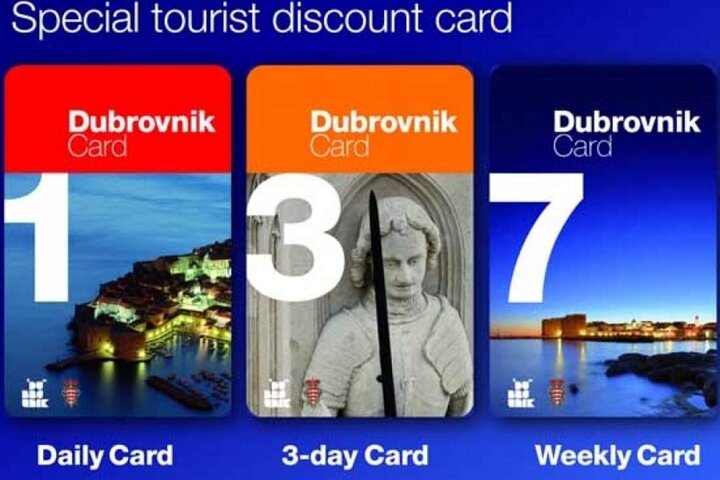
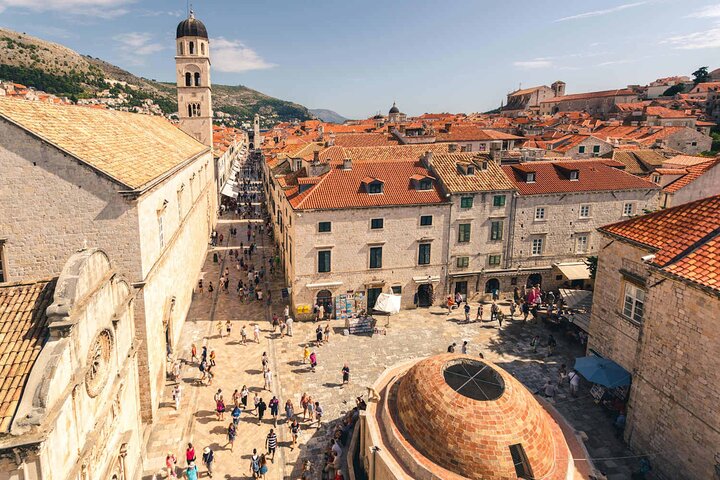
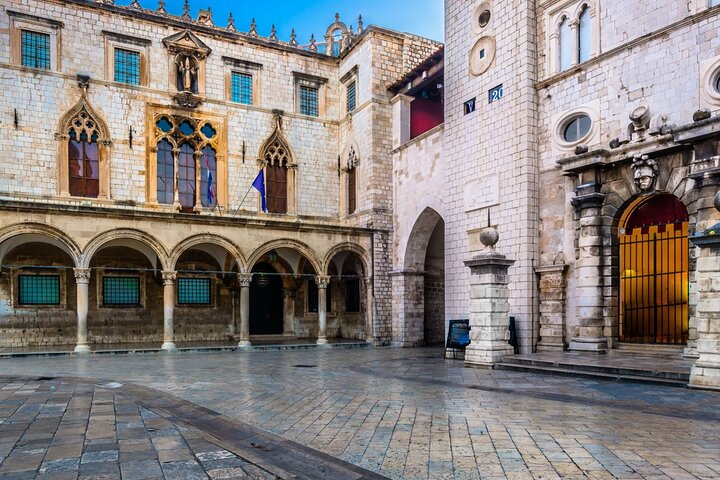
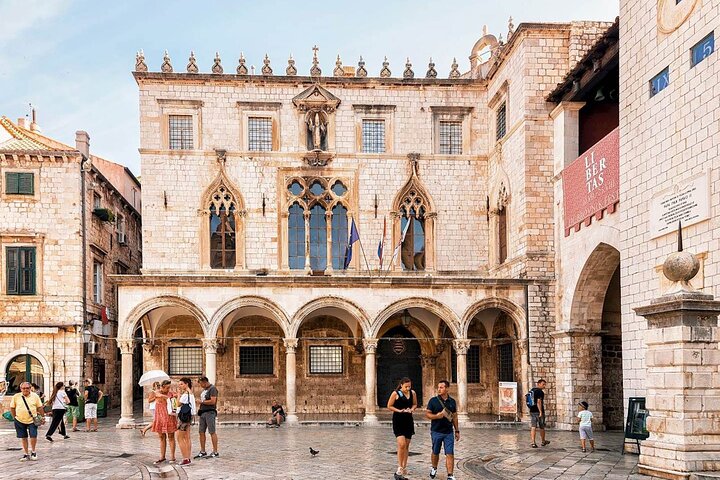
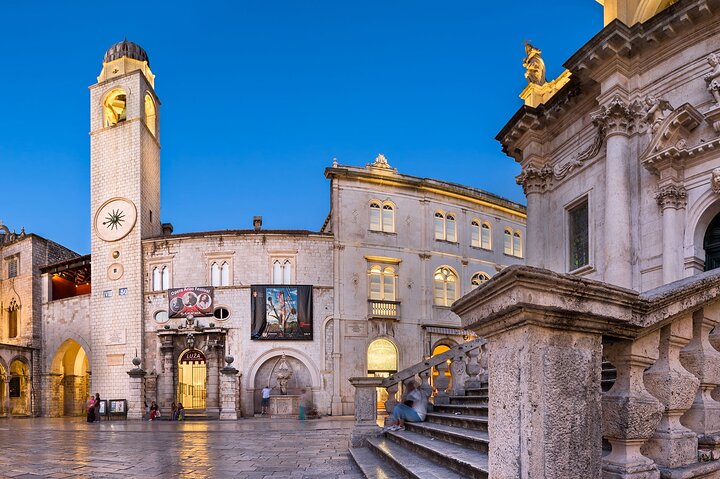
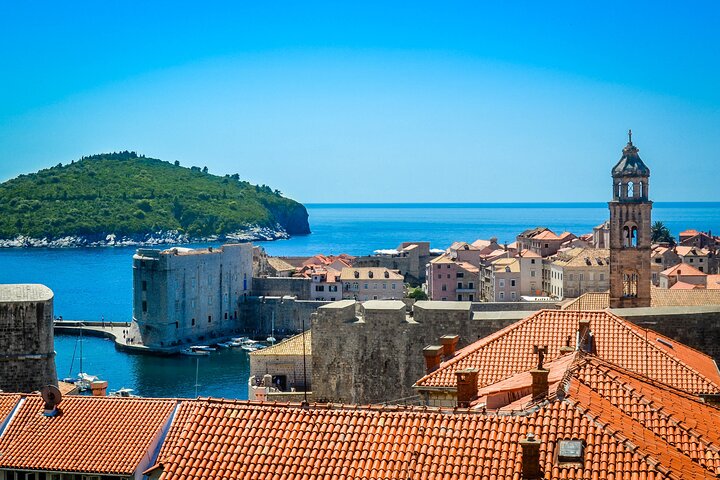
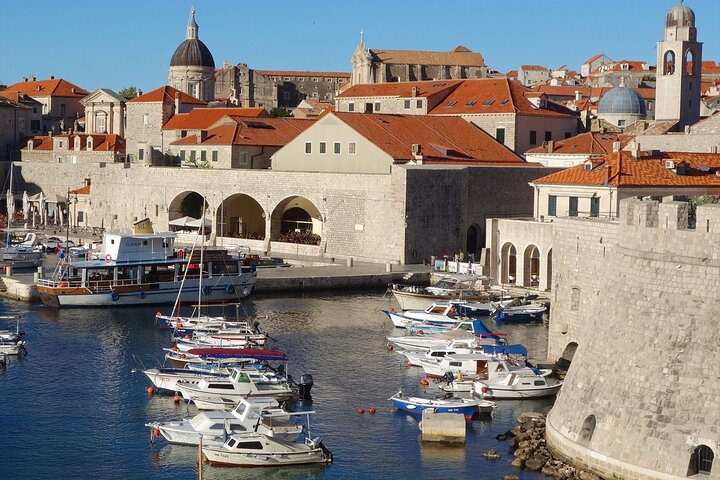







Dubrovnik /
Old city walls. No time limit for visiting.
Working Hours:
1 January – 28 February – 10.00 am – 3.00 pm
1 March – 31 March – 9.00 am – 3.00 pm
1 April – 31 May – 9.00 am – 6.30 pm
1 June – 31 July – 8.00 am – 7.30 pm
1 August – 15 September – 8.00 am – 7.00 pm
15 September – 31 October – 9.00 am – 6.00 pm
1 November – 31 December – 9.00 am – 3.00 pm
The first fortifications were built already in the 8th century, but the most intense construction took place from the mid-15th to the end of the 16th century. The huge earthquake in 1667 did not do much damage.
The ramparts encompass the city in an irregularly shaped polygon, with Fort Minčeta at the highest northwestern landward corner of the city and with Fort St. Johns on the southeastern seaside.
Strong forts, such as Fort Lawrence at Pile and Fort Revelin at Ploče, are also part of the defence system, even though they are separated from the ramparts.
Dubrovnik /
No time limit for visiting
Open:
every day except Monday,
09.00 – 20.00
The Dulčić-Masle-Pulitika Gallery was opened in a house at Držićeva poljana 1, which after the Homeland War was renovated by the American government, intending it to serve as a memorial to Ronald Brown, American Commerce Secretary, who died in an air crash flying in to Dubrovnik in 1996.
It was opened as a venue where the public could appreciate the works of three important Dubrovnik artists – Ivo Dulčić, Antun Masle and Đuro Pulitika.
In the space which is now appropriately equipped for exhibition work, as well as artist whose name the Dulčić-Masle-Pulitika Gallery bears, the Art Gallery Dubrovnik also intends to present other authors and works from its holdings, and thus to familiarise visitors with the things of value that the Art Gallery Dubrovnik and the city of Dubrovnik have in their possession.
Dubrovnik /
No time limit for visiting
Working hours
Thursday – Tuesday – 09-18
Closed on Wednesdays and on Christmas, New Year and the Feast of St. Blaise.
With over 4,000 various items, from ship models from the 17th and 18th centuries, nautical instruments, maritime maps, flags, cannons, ships logs and other rare items, it depicts the vast maritime history of Dubrovnik. The museum exhibits give an overview of the development of Dubrovnik maritime trade and shipbuilding from the very beginning, right up to the fall of the Dubrovnik Republic. Here too are exhibits which depict a renewed resurgence of Dubrovnik maritime trade and the strength of steam ships in Dubrovnik up to WWII and later.
Dubrovnik /
No time limit for visiting
Open
09:00 – 20:00
Closed on Mondays
The Museum of Modern Art Dubrovnik was founded in 1945.The building now occupied by the Museum of Modern Art Dubrovnik was originally conceived and built (1935-1939) as the showcase residential mansion of Dubrovnik ship owner Božo Banac, and in 1948 it was converted into exhibition premises and museum.
It was designed by the well-known Croatian architects Lavoslav Horvat and Harold Bilinić in the neo-Renaissance-cum-Gothic style, along the lines of masterpieces of Dubrovnik urban and villa Renaissance architecture (the Rector’s Palace, the Divona/Sponza, the Sorkočević Villa and so on).
Through the conversion works, nine exhibition rooms were created, along with two store rooms and some smaller working areas. Together with the large terraces looking on to the sea and its garden, the Museum has 900 square metres of indoor and over 1100 square metres of outdoor exhibition space.
Dubrovnik /
No time limit for visiting
Working hours
Thursday – Tuesday – 09-16
Closed on Wednesdays, Christmas, New Year and the Feast of St. Blaise.
The Ethnographic Museum is located in an old granary dating to the 16th century, where it is possible to see just how much attention the residents of Dubrovnik gave to the storage of grain. The Dubrovnik Republic kept all the state reserves of wheat, barley and millet in deep silos called Rupe, carved out of stone and coated with a water-proof material that kept the grain at a temperature of 17?C.
The traditional rural economy and architecture of the Dubrovnik region is found on the First Floor. Folk costumes and textile handiwork can be seen on the 2nd Floor.
Dubrovnik /
No time limit for visiting
With the founding of the Dubrovnik Regional Museum in 1872, the nucleus of which was the private natural history collection of the ship-owner Antun Drobac, the first foundations of the present-day museum in which valuable exhibits from our region are located were set.
Dubrovnik /
No time limit for visiting
Step back into the 16th century and visit a museum the likes of which you have never yet seen. An interesting and modern audiovisual presentation will give visitors the opportunity of becoming familiar with the life and works of the greatest Croatian Renaissance comedist from Dubrovnik, Marin Držić.
Dubrovnik /
No time limit for visiting
The Small Friar’s Pharmacy is one of the oldest in Europe, but it is the oldest in terms of its continuous service, available even today.
The year 1317 is considered as the date when both the monastery and the pharmacy were established. The pharmacy possesses one of the most priceless collections of literature on pharmacology and medicine, with over 2,000 prescriptions, as well as furniture and pharmacology equipment dating to the 15th century.
The museum also has invaluable manuscripts and chorales, paintings by unknown masters, as well as the reliquary of the head of St. Ursula dating to the 14th century.
Cavtat /
Free Entry with 3-DAY and 7-DAY Card
Working hours
Tuesday – Saturday,
9.00-19.00
Sunday,
9.00-12.00
Monday – closed
Bukovac’s birthplace is a typical bourgeois house from the late 18th and early 19th century, a two-storey building with a small garden on the south facade and a spacious back garden on the north. The house, situated in one of the small streets leading from the Cavtat seafront to Prijeko, has, since ancient times, had the continuity of a living place. During excavation of the land on the northern side of the house, remains were found of a building dating back to the Roman period, with its floor, a large number of bricks, pottery and two pots.
The house was bought by the painter’s grandfather, the Italian sailor Giuseppe Fagioni, who married in Cavtat and permanently resided there. Initially it
was built up by Bukovac’s father and then by Bukovac himself.
Općina Dubrovnik /
1-Day Dubrovnik Card offers the 24-hour use of public transport (the bus card becomes valid from the moment of first activation of the bus, and cardholders can ride the next 24 hours). No of rides limited.
3-Days Dubrovnik Card offers the 3 days use of public transport (the bus card becomes valid from the moment of first activation of the bus, and cardholders can ride the next 3 days). No of rides limited.
7-Days Dubrovnik Card offers the 7 days use of public transport (the bus card becomes valid from the moment of first activation of the bus, and cardholders can ride the next 7 days). No of rides limited.
Starting from
Dubrovnik /
Old city walls. No time limit for visiting.
Working Hours:
1 January – 28 February – 10.00 am – 3.00 pm
1 March – 31 March – 9.00 am – 3.00 pm
1 April – 31 May – 9.00 am – 6.30 pm
1 June – 31 July – 8.00 am – 7.30 pm
1 August – 15 September – 8.00 am – 7.00 pm
15 September – 31 October – 9.00 am – 6.00 pm
1 November – 31 December – 9.00 am – 3.00 pm
The first fortifications were built already in the 8th century, but the most intense construction took place from the mid-15th to the end of the 16th century. The huge earthquake in 1667 did not do much damage.
The ramparts encompass the city in an irregularly shaped polygon, with Fort Minčeta at the highest northwestern landward corner of the city and with Fort St. Johns on the southeastern seaside.
Strong forts, such as Fort Lawrence at Pile and Fort Revelin at Ploče, are also part of the defence system, even though they are separated from the ramparts.
Dubrovnik /
No time limit for visiting
Open:
every day except Monday,
09.00 – 20.00
The Dulčić-Masle-Pulitika Gallery was opened in a house at Držićeva poljana 1, which after the Homeland War was renovated by the American government, intending it to serve as a memorial to Ronald Brown, American Commerce Secretary, who died in an air crash flying in to Dubrovnik in 1996.
It was opened as a venue where the public could appreciate the works of three important Dubrovnik artists – Ivo Dulčić, Antun Masle and Đuro Pulitika.
In the space which is now appropriately equipped for exhibition work, as well as artist whose name the Dulčić-Masle-Pulitika Gallery bears, the Art Gallery Dubrovnik also intends to present other authors and works from its holdings, and thus to familiarise visitors with the things of value that the Art Gallery Dubrovnik and the city of Dubrovnik have in their possession.
Dubrovnik /
No time limit for visiting
Working hours
Thursday – Tuesday – 09-18
Closed on Wednesdays and on Christmas, New Year and the Feast of St. Blaise.
With over 4,000 various items, from ship models from the 17th and 18th centuries, nautical instruments, maritime maps, flags, cannons, ships logs and other rare items, it depicts the vast maritime history of Dubrovnik. The museum exhibits give an overview of the development of Dubrovnik maritime trade and shipbuilding from the very beginning, right up to the fall of the Dubrovnik Republic. Here too are exhibits which depict a renewed resurgence of Dubrovnik maritime trade and the strength of steam ships in Dubrovnik up to WWII and later.
Dubrovnik /
No time limit for visiting
Open
09:00 – 20:00
Closed on Mondays
The Museum of Modern Art Dubrovnik was founded in 1945.The building now occupied by the Museum of Modern Art Dubrovnik was originally conceived and built (1935-1939) as the showcase residential mansion of Dubrovnik ship owner Božo Banac, and in 1948 it was converted into exhibition premises and museum.
It was designed by the well-known Croatian architects Lavoslav Horvat and Harold Bilinić in the neo-Renaissance-cum-Gothic style, along the lines of masterpieces of Dubrovnik urban and villa Renaissance architecture (the Rector’s Palace, the Divona/Sponza, the Sorkočević Villa and so on).
Through the conversion works, nine exhibition rooms were created, along with two store rooms and some smaller working areas. Together with the large terraces looking on to the sea and its garden, the Museum has 900 square metres of indoor and over 1100 square metres of outdoor exhibition space.
Dubrovnik /
No time limit for visiting
Working hours
Thursday – Tuesday – 09-16
Closed on Wednesdays, Christmas, New Year and the Feast of St. Blaise.
The Ethnographic Museum is located in an old granary dating to the 16th century, where it is possible to see just how much attention the residents of Dubrovnik gave to the storage of grain. The Dubrovnik Republic kept all the state reserves of wheat, barley and millet in deep silos called Rupe, carved out of stone and coated with a water-proof material that kept the grain at a temperature of 17?C.
The traditional rural economy and architecture of the Dubrovnik region is found on the First Floor. Folk costumes and textile handiwork can be seen on the 2nd Floor.
Dubrovnik /
No time limit for visiting
With the founding of the Dubrovnik Regional Museum in 1872, the nucleus of which was the private natural history collection of the ship-owner Antun Drobac, the first foundations of the present-day museum in which valuable exhibits from our region are located were set.
Dubrovnik /
No time limit for visiting
Step back into the 16th century and visit a museum the likes of which you have never yet seen. An interesting and modern audiovisual presentation will give visitors the opportunity of becoming familiar with the life and works of the greatest Croatian Renaissance comedist from Dubrovnik, Marin Držić.
Dubrovnik /
No time limit for visiting
The Small Friar’s Pharmacy is one of the oldest in Europe, but it is the oldest in terms of its continuous service, available even today.
The year 1317 is considered as the date when both the monastery and the pharmacy were established. The pharmacy possesses one of the most priceless collections of literature on pharmacology and medicine, with over 2,000 prescriptions, as well as furniture and pharmacology equipment dating to the 15th century.
The museum also has invaluable manuscripts and chorales, paintings by unknown masters, as well as the reliquary of the head of St. Ursula dating to the 14th century.
Cavtat /
Free Entry with 3-DAY and 7-DAY Card
Working hours
Tuesday – Saturday,
9.00-19.00
Sunday,
9.00-12.00
Monday – closed
Bukovac’s birthplace is a typical bourgeois house from the late 18th and early 19th century, a two-storey building with a small garden on the south facade and a spacious back garden on the north. The house, situated in one of the small streets leading from the Cavtat seafront to Prijeko, has, since ancient times, had the continuity of a living place. During excavation of the land on the northern side of the house, remains were found of a building dating back to the Roman period, with its floor, a large number of bricks, pottery and two pots.
The house was bought by the painter’s grandfather, the Italian sailor Giuseppe Fagioni, who married in Cavtat and permanently resided there. Initially it
was built up by Bukovac’s father and then by Bukovac himself.
Općina Dubrovnik /
1-Day Dubrovnik Card offers the 24-hour use of public transport (the bus card becomes valid from the moment of first activation of the bus, and cardholders can ride the next 24 hours). No of rides limited.
3-Days Dubrovnik Card offers the 3 days use of public transport (the bus card becomes valid from the moment of first activation of the bus, and cardholders can ride the next 3 days). No of rides limited.
7-Days Dubrovnik Card offers the 7 days use of public transport (the bus card becomes valid from the moment of first activation of the bus, and cardholders can ride the next 7 days). No of rides limited.
We use cookies in compliance with legal regulations to improve your shopping experience. You can find detailed information here. Privacy Policy and Protection of Personal Data